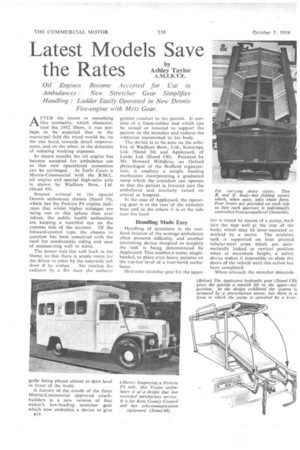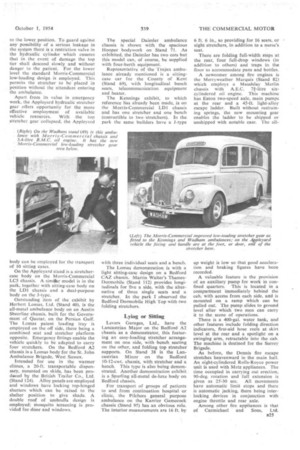Latest Models Save the Rates
Page 110

Page 111

If you've noticed an error in this article please click here to report it so we can fix it.
Oil Engines Become Accepted for Use in Ambulances : New Stretcher Gear Simplifies Handling : Ladder Easily Operated in New Dennis Fire-engine with Metz Gear.
by Ashley Taylor
A.M.I.R.T.E.
AFTER the return to something like normality, which characterized the 1952 Show, it was perhaps to be expected that in the municipal field the trend would be, on the one hand, towards detail improvement, and on the other, in the direction of reducing working expenses.
In recent months the oil engine has become accepted for ambulance use so that new operational economies can be envisaged. At Earls Court a Morris-Commercial with the B.M.C. oil engine and special high-ratio axle is shown by Wadham Bros., Ltd. (Stand 49).
Interest evinced in the special Dennis ambulance chassis (Stand 59), which has the Perkins P4 engine, indizates that whilst higher mileages are being run in this sphere than ever' oefore, the public health authorities are keeping a watchful eye on the expense side of the account. Of the forward-control type, the chassis in question has been conceived with the need for comfortable riding and ease of manceuvring well in mind.
The power unit lies well back in the frame, so that there is ample room for the driver to enter by the near-side cab door if he wishes. Air reaches the radiator by a flat duct, the radiator grille being placed almost at skirt level in front of the body.
A feature of the stands of the three Morris-Commercial approved coachbuilders is a new version of that maker's low-loading stretcher gear which now embodies a device to give B24 greater comfort to the patient. It consists of a foam-rubber bed which can be raised or lowered to support the patient on the stretcher and reduces the vibration transmitted to his body.
The device is to be seen on the exhibits of Wadham Bros., Ltd., Kennings, Ltd. (Stand 34) and Appleyard, of Leeds, Ltd. (Stand 130). Patented by Mr. Howard Wiltshire, an Oxford physiologist of the Nuffield organization, it employs a simple loading mechanism incorporating a graduated ramp which the attendant can operate so that the patient is lowered into the ambulance and similarly raised on arrival at hospital.
In the case of Appleyard, the operating gear is at the rear of the stretcher base and in the others it is at the side near the head.
Handling Made Easy
Handling of stretchers in the confined interior of the average ambulance often presents difficulty, and another interesting device designed to simplify the task is being demonstrated by Apple yard. This enables a nurse, singlehanded, to place even heavy patients on the top-tier level of a four-berth ambulance.
Hydraulic stretcher gear for the upper tier is raised by means of a pump, built into the step well at the rear of the body, which may be lever-operated or worked by a motor. The stretcher rack is supported on four pivoted tubular-steel arms which are automatically locked in vertical position when at maximum height; a safety device makes it impossible to close the doors of the vehicle until this action has been completed.
When released, the stretcher descends to the lower position. To guard against any possibility of a serious leakage in the system there is a restriction valve in the hydraulic cylinder which ensures that in the event of damage the top tier shall descend slowly and without danger to the patient. For the lower level the standard Morris-Commercial low-loading design is employed. This permits the stretcher to be placed in position without the attendant entering the ambulance.
Apart from its value in emergency work, the Appleyard hydraulic stretcher gear offers opportunity for the more effective employment of available vehicle resources. With the top stretcher gear collapsed, the Appleyard body can be employed for the transport of 10 sitting cases.
On the Appleyard stand is a stretchercase body on the Morris-Commercial LC5 chassis. A simikr model is in the park, together with sitting-case body on the LD1 chassis and a dual-purpose body on the J-type.
Outstanding item of the exhibit by Herbert Lomas, Ltd. (Stand 40), is the all-metal ambulance body on an Austin Shecrline chassis, built for the Government of Quatar, on the Persian Gulf. The Lomas patent loading tray is employed on the off side, there being a combined seat and stretcher platform opposite. Emergency fittings enable the vehicle quickly to be adapted to carry four stretchers. On the Bedford A2 chassis is a Lomas body for the St. John Ambulance Brigade, West Sussex.
Intended for use in the warmer climes, a 20-ft. transportable dispensary, mounted on skids, has been produced by the British Trailer Co., Ltd. (Stand 124). Alloy panels are employed and windows have locking top-hinged shutters which can be raised to the shelter position to give shade. A double roof of umbrella design is employed; mosquito screening is provided for door and windows. The special Daimler ambulance chassis is shown with the spacious Hooper bodywork on Stand 71. As exhibited, the Daimler has two cots but this model can, of course, be supplied with four-berth equipment.
Representative of the Trojan ambulance already mentioned is a sittingcase car for the County of Kent (Stand 69), with longitudinal bench seats, telecommunication equipment and heater.
The Kennings exhibit, to which reference has already been made, is on the Morris-Commercial LD1 chassis and has one stretcher and one bench (convertible to two stretchers). In the park the same builders have a J-type with three individual seats and a bench.
The Lomas demonstration is with a light sitting-case design on a Bedford CAZ chassis. Martin Walter's ThamesDormobile (Stand 112) provides longitudinals for 'five a side, with the alternative of three single seats and a stretcher. In the park I observed the Bedford Dormobile High Top with two folding stretchers.
Lying or Sifting
Levers Garages, Ltd., have the Lancastrian Major on the Bedford A2 chassis as a demonstrator, this featuring an easy-loading stretcher arrangement on one side, with -bench seating on the other, and folding top stretcher supports. On Stand 38 is the Lancastrian Minor on the Bedford 10-12-cwt. chassis, with stretcher and a bench. This type is also being demonstrated. Another demonstration exhibit is a Spurting all-metal de-luxe body on Bedford chassis.
For transport of groups of patients to and from continuation hospital or clinic, the Pitchers general purpose ambulance on the Karrier Gamecock chassis (Stand 95) has an obvious role. The interior measurements are 16 ft. by 6 ft. 6 in., so providing for 16 seats, or eight stretchers, in addition to a nurse's seat.
There are folding full-width steps at the rear, four full-drop windows (in addition to others) and traps in the floor to accommodate pans and bottles.
A newcomer among fire engines is the Merry weather Marquis (Stand 82) which employs a Maudslay Merlin chassis with A.E.C. 7f-litre sixcylindered oil engine. This machine has Eaton two-speed axle, main pumps at the rear and a 45-ft. light-alloy escape ladder. Built without restraining springs, the new mounting gear enables the ladder to be shipped or unshipped with notable ease. The all up weight is low so that good acceleration and braking figures have been recorded.
A valuable feature is the provision of an auxiliary pump for work in confined quarters. This is located in a compartment immediately behind the cab, with access from each side, and is mounted on a ramp which can be pulled out. The pump slides to ground level after which two men can carry it to the scene of operations.
There is a 400-gal. water tank, and other features include folding direction indicators, first-aid hose reels at skirt level at the rear and a spotlight on a swinging arm, retractable into the cab. The machine is destined for the Surrey Brigade.
As before, the Dennis fire escape stretches heavenward in the main hall. An eight:.cylindered Rolls-Royce power unit is used with Metz appliances. The time occupied in carrying out erection, 90-deg. rotation and full extension is given as 25-30 sec. All movements have automatic limit stops and there is automatic jacking, there being interlocking devices in conjunction with engine throttle and rear axle.
Among other fire appliances is that of Carmichael and Sons, Ltd.
• B25




























































































































































